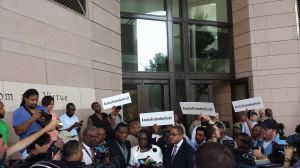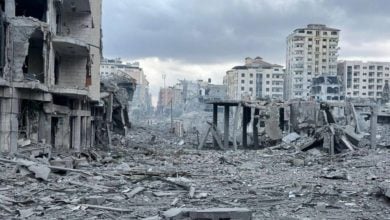
On Sept. 14, 2013, in Charlotte, North Carolina—Jonathan Ferrell, a former college football player, was slain by cop Randall Kerrick. Almost two years later, another dead Black person is on trial—rather than the cop who killed him. There is no doubt that Kerrick killed Ferrell; the trial centered on the charge of “voluntary manslaughter.” However, by a vote of 8 to 4 a “mistrial” was declared.
Immediately after the mistrial ruling, a group of people, who had been at the courthouse all week for the trial, held a “die-in,” while chanting “No Justice, No Peace”, “Unarmed, Don’t Shoot” and “Black Lives Matter.” This was not a planned action, but with every media outlet on-site the crowd grew rapidly. Moving from the “die-in”, the crowd proceeded to the intersection in front of the courthouse—the crowd blocked traffic, holding signs reading “Justice for Jonathan Ferrell” for on lookers to see.
After a half an hour of rallying, the Ferrell family—Jonathan’s mother and brother—along with their lawyer, came out to speak with the press. Willie Ferrell, Jonathan’s brother, emphatically said, “I am Jonathan Ferrell”, greeted by a supportive community that yelled back, “We are all Jonathan Ferrell.” After answering a few questions, the family urged supportive community members to petition for a retrial.
Once the brief press conference ended, the crowd began to march towards downtown. With high energy the group chanted, sang “Eyes on the Prize” and continued the march.
Making multiple stops including the transit authority, a higher-end shopping center called the Epicenter, in front of the Bank of America tower and the new BB&T Baseball Park–an estimated 20 intersections were blocked during the first two hours.
After the final “die-in” right in the middle of Trade St. and Tryon St, the middle and busiest downtown intersection, the final leg of the first half of the march culminated in a rally at the police station. A speak out ensued, people from all over Charlotte expressed their deepest condolences for the Ferrell family and demanded a retrial.
The crowd seemed in relative in agreement until a handful of people mentioned voting and “Black-on-Black crime.” The dissenting group expressed the opinion that “voting wasn’t doing anything” and that the “oppressor should not tell you how to protest” and with that the second half began.
As the march reignited the mood shifted altogether. A harmonious, non-confrontational action became a powerful, militant struggle. With numbers peaking at 120, indignation filled the air.
The crowd embarked on a similar path but instead of “die-ins” at intersections, the baseball stadium became the new target. During the first stop at the field the game had just begun; during the second leg the game was nearly over and people circled the stadium chanting “Black Lives Matter.” In all the action was six hours long.
This is when protest turned to rebellion. A few rocks and bottles were thrown, signs were knocked over and some in the crowd sat on a police car, but remember Kerrick murdered Ferrell with 12 shots. No amount of property damage equals the taking of someone’s life.
Even after the grueling six hours, the crowd seemed as invigorated as they were at the beginning. Two people were arrested, between 80 and 120 people marched and the police presence was larger than the action, including two helicopters, police in carts, on bikes and ending with the deployment of riot police. The sheer number of police was an outrageous show of force by the state.
On August 22, Jonathan Ferrell was denied justice. Randall Kerrick walked free and an indignant group rose up to demand a retrial in hopes of jailing a killer cop. This community response began the process of grasping justice that the state so readily denied.






